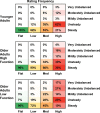Uneven terrain treadmill walking in younger and older adults
- PMID: 36534645
- PMCID: PMC9762558
- DOI: 10.1371/journal.pone.0278646
Uneven terrain treadmill walking in younger and older adults
Abstract
We developed a method for altering terrain unevenness on a treadmill to study gait kinematics. Terrain consisted of rigid polyurethane disks (12.7 cm diameter, 1.3-3.8 cm tall) which attached to the treadmill belt using hook-and-loop fasteners. Here, we tested four terrain unevenness conditions: Flat, Low, Medium, and High. The main objective was to test the hypothesis that increasing the unevenness of the terrain would result in greater gait kinematic variability. Seventeen younger adults (age 20-40 years), 25 higher-functioning older adults (age 65+ years), and 29 lower-functioning older adults (age 65+ years, Short Physical Performance Battery score < 10) participated. We customized the treadmill speed to each participant's walking ability, keeping the speed constant across all four terrain conditions. Participants completed two 3-minute walking trials per condition. Using an inertial measurement unit placed over the sacrum and pressure sensors in the shoes, we calculated the stride-to-stride variability in step duration and sacral excursion (coefficient of variation; standard deviation expressed as percentage of the mean). Participants also self-reported their perceived stability for each condition. Terrain was a significant predictor of step duration variability, which roughly doubled from Flat to High terrain for all participant groups: younger adults (Flat 4.0%, High 8.2%), higher-functioning older adults (Flat 5.0%, High 8.9%), lower-functioning older adults (Flat 7.0%, High 14.1%). Similarly, all groups exhibited significant increases in sacral excursion variability for the Medium and High uneven terrain conditions, compared to Flat. Participants were also significantly more likely to report feeling less stable walking over all three uneven terrain conditions compared to Flat. These findings support the hypothesis that altering terrain unevenness on a treadmill will increase gait kinematic variability and reduce perceived stability in younger and older adults.
Copyright: This is an open access article, free of all copyright, and may be freely reproduced, distributed, transmitted, modified, built upon, or otherwise used by anyone for any lawful purpose. The work is made available under the Creative Commons CC0 public domain dedication.
Conflict of interest statement
The authors have declared that no competing interests exist.
Figures









References
Publication types
MeSH terms
Associated data
Grants and funding
LinkOut - more resources
Full Text Sources
Other Literature Sources

